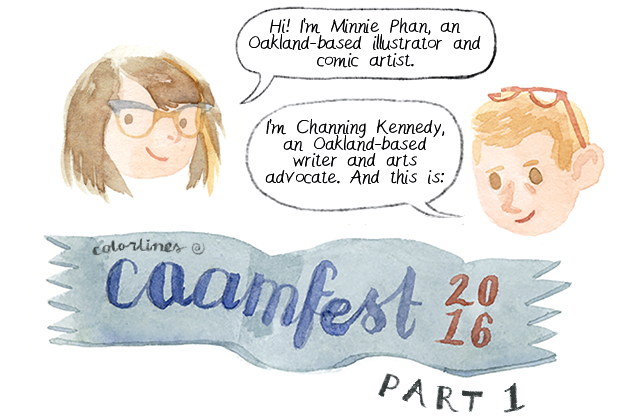The assignment was straightforward. A Colorlines editor asked Oakland-based writer and arts advocate Channing Kennedy if he wanted to cover the The Center for Asian American Media’s signature festival, CAAMFest 2016. He had an intriguing idea: "Let’s make it a reported comic!" The editor said, "Hmm. A comic? OK. Yes." So Kennedy sought out Oakland illustrator and comic artist Minnie Phan. This duo covered so much, we’re doing their report-back in several parts. Here’s the first. (Note: The size of the writing, says Kennedy, is "standard." The comics-ignorant, eye-straining editor said,"OK," and then pasted the text at the bottom. Old school for the win.) —Eds.
{{image:1}}
{{image:2}}
{{image:3}}
{{image:4}}
{{image:5}}
Colorlines at CAAMFest 2016, Part 1 Script
The Center for Asian American Film has been running CAAMFest (formerly the San Francisco International Asian American Film Festival) in the Bay Area since 1982. Through a combination of innovative connections, corporate sponsorships and sheer tenacity, it’s become the world’s largest showcase of new Asian and Asian-American cinema.
To understand CAAMFest’s necessity, one need look no further than the lily-white 2016 Academy Awards’ use of three Asian children as a prop for a racist one-two punch line about math and child labor
So. What does cinema look like when Asians tell their own stories?
Panel: "A Brave New Digital World"
On the "A Brave New Digital World" industry panel, recruiters of self-made media stars—“influencers”—temper their optimism with realism.
“In 2016 you’ll see the emergence of the ‘middle class’ of Internet video —the space between YouTube and, say, Amazon,” said Philip W. Chung, creative director of YOMYOMF.
“Being in this industry is a marathon, not a sprint. Once you get to that position of power, then you have more say over the stories that get told. … There’s a lot of education that has to happen as we find these influencers,” said Karen Horne, senior vice President of Programming Talent Development and Inclusion and NBC Entertainment and Universal Television Studios.
But a lot of young media creators—especially women, people of color, queer and trans folks and folks with disabilities—are forced off the Internet by harassment and threats of violence, anonymopus or otherwise. How does one search for new diverse voices when the pool has been pre-filtered, not just by economics, but by actual hate mobs?
“Before being at Machinima, I didn’t realize how toxic it is. …We premiered the first video by one of our new creators, a Puerto Rican teenager, at six in the morning, then spent the next two hours deleting racist comments. I reached out to warn him, and he said, ‘Don’t worry, I was expecting this,’" said Pradeepa Jeeva, director of development at Machinima Inc. "It’s fucked up.”
“Before we work with you, Disney Standards and Practices goes through your entire back catalog, to check for anything objectionable,” said Gary King, network executive, Disney/ABC Cable Networks Group.
Disney’s policy says, for better or worse, that they’re more worried about their stars being bullies than being bullied. And, as audience member Neil Sehgal, producer of the 2009 Randall Park short "Blueberry"
points out: “We could never get on Disney, because of the jokes we’ve made about ourselves.”
Film: "Colma the Musical"
Of course, artists don’t need permission. CAAMFest 2016 marked the ten-year anniversary of the cult Bay Area classic "Colma the Musical," made in 2006 for $1000.
Written by, composed by and starring H.P. Mendoza, and based on his experiences as a young gay Filipino growing up in (and yearning to get out of) the titular mall-riddled Bay Area town, "Colma" tells a universal story through uncelebrated people.
Minnie says: "I went into this live sing along not knowing any of the words but, as someone who grew up
queer and Vietnamese in the South Bay, I knew all the feelings." Minnie had no idea what she was singing, but she was singing it loudly.
Film: "The Fast and the Furious: Tokyo Drift"
On the opposite end of the spectrum from "Colma," CAAMFest 2016 also celebrated the 10-year anniversary of: "The Fast and the Furious: Tokyo Drift."
“We’re gonna get a little misogynistic tonight, is that all right?” asked the CAAMFest emcee. “NO,” said the audience.
"Tokyo Drift" is, or was going to be, a movie about a White kid who breaks the law so much that he gets a free trip to Japan. To solve issues with the screenplay, director Justin Lin created the character ‘Han Seoul-Oh’
(whose last name isn’t said in the film). Bad puns aside: Han is the best.
Han is a genuinely cool, charismatic character whom you love seeing on screen, and he’s neither stereotypically Asian nor "happens to be" Asian. (As a result, it’s hard to imagine him surviving a focus group.) His immediate fan-favorite status, and continuance on into the sequels, speaks volumes about how behind-the-camera representation can translate into
successes both artistic and fiscal.
Says Minnie: "Seeing this movie 10 years ago in the theater, my cousins freaked out about every new car that came on screen. This movie is surprisingly documentarian for me! Like a tour of every hot-rod-and-bikini-babe poster in my friends’ brothers’ bedrooms. It’s… unclear how far we’ve come."
Adds Channing: "I’m reminded of the late Roger Ebert in at Sundance 2002, roasting a fellow White audience member for telling Asians how to “represent” themselves. This movie—this very silly movie—is
the one Lin set out to make.
One last bit of trivia from the pre-show panel: Argentina-born, Australia-raised actor Leonardo Nam says he based his bleach-blonde Yakuza character on the neo-Nazi hipsters he’d seen while shooting an indie film in Berlin. Huh!
Stay tuned for the part 2 of Colorlines @ CAAMFEST2016!
